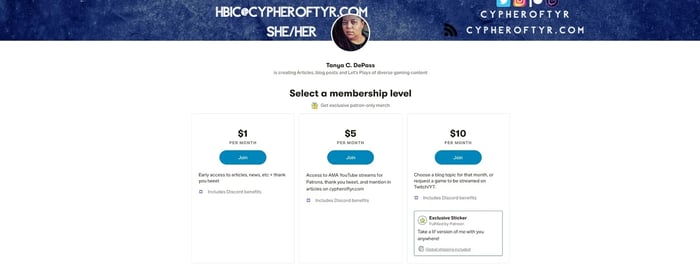Blogging can be expensive, even on a free platform like WordPress. Making money through WordPress is the best way to offset the costs of crafting posts, paying your hosting provider, domain renewal fees, security certifications, and any premium plugins you use.

Of course, all approaches to monetizing a WordPress blog require some extra work, and there’s no surefire way to get rich quickly — if that were true, there would be many more bloggers out there. However, you can try a handful of well-worn strategies successful bloggers use for yourself.
This post teaches you the seven best ways of how to monetize your blog. We’ll review each in terms of pros and cons, so you can pick one that works best for your content, schedule, and audience.
How to Monetize a WordPress Blog
- Place display ads.
- Become an affiliate marketer.
- Write sponsored blog posts.
- Sell exclusive content.
- Sell merchandise.
- Offer membership.
- Ask for donations.
1. Place display ads.
Often the simplest way to monetize WordPress is through display advertisements. These ads may appear on your pages as static displays, popups, and/or native ads. It may even make sense to install a WordPress theme with ad space if you think this is the right direction for your website.
The two most common payment models for display ads are pay-per-click (PPC) model and the pay-per-impression (PPI) model. In a PPC model, you receive payment whenever someone clicks on a display ad on your site. In a PPI model, you’re paid whenever a user sees an ad. PPC models will earn you more as long as users click them at a consistent rate.
To place display ads, bloggers partners with advertising networks, companies that pair advertisers with websites to host ads. Your network pays you for your ad clicks/impressions and determines which ads will appear on your site, so be sure to choose a reputable network if you opt to show ads.
Far and away, the most popular ad network for WordPress is Google AdSense. AdSense is free, easy to use, and supports the widest pool of targeted ads on any network. It operates on the PPC model and gives publishers 68% of the profit from each ad click a competitive rate.
AdSense isn’t the only option, however — there are plenty of Google AdSense alternatives to try as well. Some offer better payouts, and others have looser content requirements to become a partner. It’s worth some research into your options before defaulting to AdSense.
Ads are a common route for newer bloggers to generate passive income from their blogging efforts. However, there are some things you should know before trying yourself:
- Reputable networks like AdSense have pretty strict requirements you must meet to become a partner. One common requirement is having an existing catalog pool of quality blog posts. Brand-new bloggers likely won’t be eligible on this basis.
- You’ll need a good amount of traffic to earn significant income from display ads, let alone a full-time salary. Some ad networks have a minimum monthly traffic requirement to even get started.
- Users generally find ads occasionally useful at best and frustrating at worst, especially if you place too many per page. A blog cluttered with distracting ads can damage trust with your readers.
- Many users install ad blockers or develop “banner blindness” — both are obstacles to display ad monetization.
Still, display ads are one of the easier ways for bloggers to generate passive income, as long as they have enough content and traffic to bring clicks and impressions. You might choose this strategy as a step toward something more lucrative.
2. Become an affiliate marketer.
The second passive income opportunity we’ll discuss is affiliate marketing. Compared to advertisements, this option is better for the user experience and has the potential to be more profitable. According to Business Insider, 15% of digital marketing revenue comes from affiliate programs.
Here's a quick overview of using affiliate marketing for businesses. This can help give you ideas on what to use for your blog.
Affiliate marketers promote third-party products in their blog content. They mention products in their blog posts and place special affiliate links, which visitors can follow and purchase the product on the third-party website.
Your affiliate links are tagged with a unique tracking code, which signals to the merchant that the traffic came from your blog. When visitors purchase a product on their website through this your identifying link, you receive a slice of the revenue.
Blogs are a particularly good platform for affiliate marketing because there are many opportunities for affiliate link placement. For example, you could write a review of a product or mention a product in a post about some larger topic.
Amazon Associates is the biggest player in the affiliate marketing space, with over two million affiliates. With Amazon Associates, you can place affiliate links for any product available on Amazon and get rewarded for any purchase on the site through your link (not just products you promote). Placing these links on WordPress is relatively easy, and there are even plugins to help manage your Amazon links.
Besides Amazon, there are alternative affiliate networks, and many companies also offer their own affiliate program — like HubSpot's affiliate program, for example. Think of a product you enjoy, and check whether they offer on their website. You can also start with our list of the best affiliate programs.
Interested? Here are some tips for getting started with affiliate marketing on WordPress:
- The best affiliate marketers truly enjoy and benefit from the products they promote. Be genuine and selective about your products so readers will trust your recommendations.
- Follow the rules for your affiliate program(s) and always disclose in your post when your links are affiliate links.
- Like display ads, you won’t profit from an affiliates program if you lack an audience. Build out your readership with excellent content before placing affiliate links.
- Promote products within your area of expertise. There’s no need to change your content to suit your monetization strategy — there’s likely an affiliate marketing program within your blogging topic.
3. Write sponsored blog posts.
As an established writer, you can secure sponsorships, in which brands pay you to mention or review their products in your posts. While devoting entire posts to a product takes more effort on your part, you can earn a lot more than affiliate marketing and display ads. And if you regularly publish reviews, you can connect with brands you already cover.
If companies aren’t contacting you to propose sponsored content, it’s on you to reach out to brands requesting sponsorship. Having an established reader base will make brands much more likely to agree to a sponsorship deal.
As with affiliate marketing, be mindful of your sponsorship choices and genuine with your recommendations and opinions. You’ve worked hard to create content that generates enough buzz, and readers will notice if you pivot from your niche.
Finally, be mindful of the difference between sponsored content and native advertising. Native ads are a type of display advertising that blends in with the rest of your content and are created by advertisers. You author your own sponsored content.
4. Sell exclusive content.
After blogging for a while, you’ve likely honed your expertise on a topic and helped your readers do the same. Another common monetization strategy among experienced bloggers is premium content.
Premium content should cover topics within your blogging niche, but offer insights beyond your standard blog posts. If you’re wondering what content would provide value to readers, consider one of many possible content types:
- Exclusive posts: These posts provide extra value in addition to your free posts. Exclusive blog posts can be entirely new pieces, or they could expand or augment existing posts.
- Printable blog posts: Another option is converting your longest posts into printable PDFs that users can purchase. You might also add some bonus exclusive content to these PDFs, like a summary or worksheet for instructional posts. One of my favorite writers, Tim Urban of the popular blog Wait But Why, utilizes this method.
- Ebooks: Ebooks are well-suited for blogs. They take less time and effort to produce than other forms of content, they’re typically affordable, and you can even create one from old blog content. In fact, we have a free ebook to help you start making your own.
- Courses: The next step above an ebook is a full online class around your topics. Use your existing blog content as a starting point, and present your knowledge in a digestible format for students via written and/or video content. This will take some serious effort, but you can utilize an e-learning plugin like LearnPress to help build out your course.
And that’s just the beginning — you could try your hand at a podcast, photo collections, live streams and webinars, or a service such as consulting or even freelance writing. Anything you can place behind a paywall is fair game.
To sell readers on your paid offer, however, you need to prove your value with free content first. In addition to your public blog posts, you can create free versions of any of the content types I’ve listed. This will signal your knowledge and quality to old and new readers before they start spending.
5. Sell merchandise.
Buying merchandise is an effective way for loyal readers to support your work and promote your brand. Similarly to paid content, you can also sell physical products on your site through an online store.
There are many free and paid WordPress ecommerce plugins that can add a store component to your existing blog, or convert your site to a store with a blogging component.
Here's a helpful video by YouTuber Graham Stephan on how he uses merchandise to make money for his YouTube channel.
6. Offer membership.
A membership website offers access to gated content for members. Membership blog sites can also grant access to a community forum or message board for fans to discuss your posts and interact with you.
This monetization method is more reliable than one-time paid content since membership costs are recurring, but it’s also far more work. Not only do you need to garner a large enough following and prove your value with free resources, but you also need to shift your content strategy to accommodate for regularly updated premium content. If you’re ready for the commitment, see our guide to creating a membership site in WordPress.
However, this guide would be incomplete if we didn’t mention an alternative membership service, Patreon.
Patreon a platform that allows fans to sponsor creators monthly in exchange for exclusive membership content. You can set membership tiers on your Patreon page with increasing perks for each tier, and place CTAs on your blog asking for support.

Patreon handles the content gating, membership tiers, and payments for you in exchange for a percentage fee from your recurring revenue. If you’re ok with the cost, Patreon is a lightweight alternative to building a membership site from scratch.
Here's an in-depth tutorial explaining how you can leverage Patreon for your business
7. Ask for donations.
If you lack the time and resources to produce exclusive paid offers, you can request one-time or recurring donations from your readers.
While donations are less likely to bring consistent income, they’re a low-effort, low-key approach that lets you focus on your writing above all else. Getting started is as simple as placing CTAs to a payment processor like PayPal, and a PayPal plugin for WordPress can help integrate this processor with your site.
Note that the term “donation” can connote a charitable cause or nonprofit mission. Be careful about using that word, especially if you use this method in conjunction with other monetization strategies. Asking for donations while pushing ads can be disingenuous — using the word “Support” or setting up a Patreon page might be a better alternative for crowdsourced revenue.
Monetizing Your WordPress Blog
Because WordPress websites are so flexible, there are plenty of ways to profit from a WordPress blog. While each method will work well for a specific type of creator, no solution is perfect. All monetization strategies we’ve listed have their own pros and cons, and all require at least a decent, stable following to bring meaningful returns.
That’s why, above anything else, you should focus your energy on the quality of your blog and the value readers come away with. There’s no quick and easy way to profit from blogging alone, but practice, trial and error, and serving your niche will, quite literally, pay off.
![Download Now: How to Launch a WordPress Website [Free Guide + Checklist]](https://no-cache.hubspot.com/cta/default/53/b5ae83fa-3a09-487e-a43a-4833bf87ab87.png)










